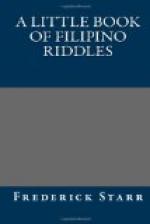“Cut and no wound seen?” “Water,” is our number 231.
“The mother says let us stand up, but the children say let us lie across?” “A ladder.” and “At night they come without being fetched and by day they are lost, without being stolen?” “The stars.” are quite in the style and spirit of Filipino riddles. Compare “Coarse rafia cloth outside and white robe inside?” “Manioc root” with the “Poor outside; rich within,” “Langca” of the Ilocano.
The order of presentation of these riddles has been a considerable problem. To arrange them rigidly in Petsch’s order of development might have been fairly satisfactory but would have rendered the finding of any desired riddle difficult. We have struck out a crude arrangement in alphabetical order of the English answers, with subdivisions under some general headings. The arrangement is not scientific nor completely developed, but it will perhaps work fairly well in practice. The original text is first given for riddle and answer; the English translation of both follows; then are given such explanation and comment as are necessary. When a riddle occurs in different languages, the text of the question is given in one, but the fact of its occurrence in others is indicated.
We are indebted to many for assistance. The list is too long for individual acknowledgment. To our original Ilocano helpers this little book is dedicated. To Messrs. George T. Shoens, Francisco A. Santos (Calumpit), Rufino Santos (Arayat) and Conrado Benitez (Pagsanghan), we are so deeply indebted that their names must be mentioned. To school boys in Agoo, San Fernando (Union), Malolos, Manila and Tayug, we owe many thanks. Would that the publication of this imperfect collection might lead to their greater interest in a neglected section of their folklore. Some Malay worker ought to perfect and complete the work here begun.
This volume is the first number of a series of little books which the undersigned plans to bring out under the general title of Philippine Studies. Each number will treat of a distinct and separate subject; each will be independent. The extent to which the series will be developed, will depend upon the reception given to it and the degree in which it appears to respond to a real need. Two numbers at any rate are already arranged and the second should appear within a year.




